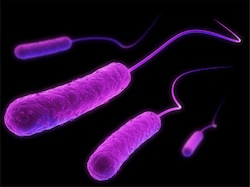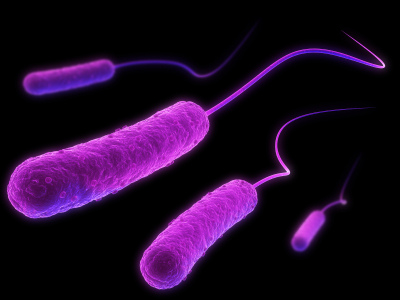Swimming Microbes Change Fluid Viscosity
Blood is thicker than water, or so the old proverb goes. But that all depends on what sorts of microbes are living and swimming in the water, according to new experiments. In the 2 October 2009 and 5 March 2010 Physical Review Letters, two research teams report that swimming single-celled organisms can dramatically change the viscosity of a fluid depending on how they propel themselves. The experiments confirm some of the theoretical understanding of the effects of microscale swimmers on a fluid, but they also open new questions for theorists to explain. A deeper understanding is important for microfluidic devices that manipulate samples of living cells and could also be relevant for future swimming micromachines.
Organisms that propel themselves through a fluid are either “pushers,” which use rear-mounted propellers, or “pullers,” which use front-mounted flagella the way a human swimmer uses her arms. The two types exert different forces on the surrounding fluid. Pushers force fluid back behind them with their propellers and also push it forward with their bodies as they move, so that the fluid is sucked in at the sides and moves away at the front and back. Pullers pull fluid towards them with their flagella and drag it along with them from behind, so that it flows in at the front and back and away at the sides.
This flow pattern can affect the large-scale flow of a fluid if it contains enough of these swimmers and if they are rod-shaped, according to a theory published in 2004 [1]. Imagine that the fluid above the rod is moving to the right, while the fluid below is moving to the left. According to standard theory, in this flow, a rod–even a passive, non-swimming one–tends to align at a fixed angle, tilted to the right of vertical (a sphere, by contrast, would continually rotate). In this orientation, a pusher rod increases the flow velocities above and below, whereas a puller reduces them. Viscosity is a measure of the ease with which the fluid moves in such a shear flow in response to applied forces. So a rod-shaped puller ought to increase viscosity, whereas a rod-shaped pusher ought to decrease it.
In October, Andrey Sokolov and Igor Aranson of the Illinois Institute of Technology and Argonne National Laboratory, both in the Chicago area, reported that solutions of Bacillus subtilis, a rod-shaped, pusher-type bacterium, do indeed exhibit as little as one-seventh the viscosity of water. To measure the viscosity, they used two new techniques, both involving fluorescent particles as “tracers” of the flow. In the first, they created tiny vortices and measured their decay time; in the second, they applied a controlled twisting force to a magnetic particle in the solution and measured the fluid’s resulting rotational speed.
In addition, Sokolov and Aranson were able to slow the bacteria’s swimming speed by cutting off their oxygen supply. The slower they swam, the smaller the decrease in viscosity. In essence, the team says, the bacteria convert chemical energy into fluid motion, easing its flow and making the solution thinner.
To examine cells that move by pulling, Salima Rafaï, Levan Jibuti, and Philippe Peyla of the Joseph Fourier University in Grenoble, France, conducted experiments with Chlamydomonas reinhardtii, a type of single-celled green algae. Spherical in shape, the algae have two front-mounted flagella that pull them forward in what the team calls a “jerky breast stroke.” The team tested samples of both living and dead cells. To measure the viscosity of the samples, they used a standard rheometer, which applies a known twisting force to a cone immersed in the fluid and measures the resulting rotation.
For both living cells and dead cells, the viscosity increased with concentration, but for living cells the viscosity increased much faster. At a concentration of 15 percent, the viscosity of the living cell solution was twice that of the dead cell solution. The team also took high-speed videos of the cells as they moved in a flow similar to that in the rheometer. The dead cells moved along with the flow, slowly tumbling just as plastic beads would. But the living cells resisted tumbling, flipping quickly only once every few seconds.
Peyla and his colleagues cannot explain why these pullers can affect the viscosity. The cells are spherical, so they don’t fit the 2004 theoretical analysis, which assumes rod shapes. And the live cells align parallel to the flow direction, not at the angle assumed in the 2004 theory paper. The researchers can only speculate that as in the 2004 theory, the fixed alignment of the cells is essential, and that it’s somehow maintained by the beating of the C. reinhardtii flagella. They suggest that gravity might be aligning the cells because of their off-center center-of-mass, just as a clock hung on a wall hook rights itself after being bumped. Another possibility, they say, is that the flow pattern around the cell makes it behave somewhat like a passive rod, which automatically remains aligned.
Howard Stone, a fluid dynamics expert at Princeton University, calls the work “novel” and adds, “If one wanted to dream a little, one could imagine trying to use these active suspensions to actively adjust the viscosity of a solution.” Rafaï even suggests that these techniques may be useful for quantifying the motility of sperm cells for fertility treatment by examining the overall viscosity of the fluid in which they swim.
–Michelangelo D'Agostino
Michelangelo D’Agostino is a physicist and freelance science writer in Berkeley, California.
References
- Y. Hatwalne, S. Ramaswamy, M. Rao, and R. A. Simha, “Rheology of Active-Particle Suspensions,” Phys. Rev. Lett. 92, 118101 (2004)





